
THE ONTARIO VETERINARY COLLEGE FALL 2022 / WINTER 2023 FREE COPY pettrust.ca TUMOUR TECH GETS LIT OVC TRIALS NEW TECHNOLOGY TO ILLUMINATE AND DESTROY TUMOURS
THE PET MAGAZINE OF
Since its inception, OVC Pet Trust has lived up to its promise to support the rich history of the Ontario Veterinary College (OVC) by enabling discovery in companion animal medicine, investing in infrastructure to create state-of-the-art healthcare facilities and providing support for advanced training and education.
OVC Pet Trust is a differentiating factor for OVC. As the bridge that connects pet owners, industry and veterinary professionals with the forefront of care, we continually push the boundaries in veterinary medicine to achieve excellence in innovation, education and healthcare. We could not do it without our dedicated supporters and generous donors.
The landscape of veterinary medicine is changing, and we recognize we have many challenges ahead of us.

The demand for complex veterinary care is dramatically increasing. Pet ownership is growing at a rapid rate, creating new pressures in the fields of veterinary medicine and animal welfare. And, as the value of the human-animal bond and the key role animals play in our own well-being is more widely accepted and understood, social justice issues related to diversity, inclusion and access to care must be addressed.
I hope you enjoy this issue of OVC Pet Trust’s Best Friends Magazine. Thank you for partnering with us as we keep pushing the needle to improve and advance companion animal health and well-being.
Dr. Jeff Wichtel Dean and Professor Ontario Veterinary College University of Guelph
As part of the Ontario Veterinary College (OVC) at the University of Guelph, OVC Pet Trust is Canada’s first charitable fund dedicated to advancing pet health and well-being.

2
TO LEARN MORE OR TO DONATE VISIT PETTRUST.CA Connect with OVC Pet Trust on Instagram @OVCPetTrust pettrust.ca BEST FRIENDS Published twice per year by OVC Pet Trust. EDITORIAL TEAM Jane Dawkins Katherine Galley Ashleigh Martyn Kim Robinson CONTRIBUTORS Suzi Beber Caitlin Ford Rishta Jahan Karen Mantel Lisa McLean GRAPHIC DESIGNER Allison Graef OVC PET TRUST BOARD Mary Beaton, Colin Campbell, Dr. Doreen Houston (Chair), Dr. Karyn Jones, Kim Lang, Dr. Jennifer Ogeer, William Pringle, Dr. Rebecca Sterns, Roland Browning Watt, Dr. Jeff Wichtel. Honorary: Roger Warren. Ex-officio: Dr. Luis Gaitero, Tara McNeice, Kim Robinson, Dr. Shayan Sharif. CONTACT OVC PET TRUST Ontario Veterinary College University of Guelph 50 Stone Road Guelph ON N1G 2W1 T. 519-824-4120 x 54695 E. ovcpet@uoguelph.ca GIVE TO OVC PET TRUST pettrust.ca/donate ABOUT OVC PET TRUST
We do this by raising funds to support innovative discoveries, healthcare and education that improves the prevention, diagnosis and treatment of diseases of companion animals. Since 1986, more than $73.5 million has been raised to improve life for pets and the people who love them. In 2022, OVC ranked first in Canada and fifth in the world for veterinary science by Quacquarelli Symonds’ World University Rankings.
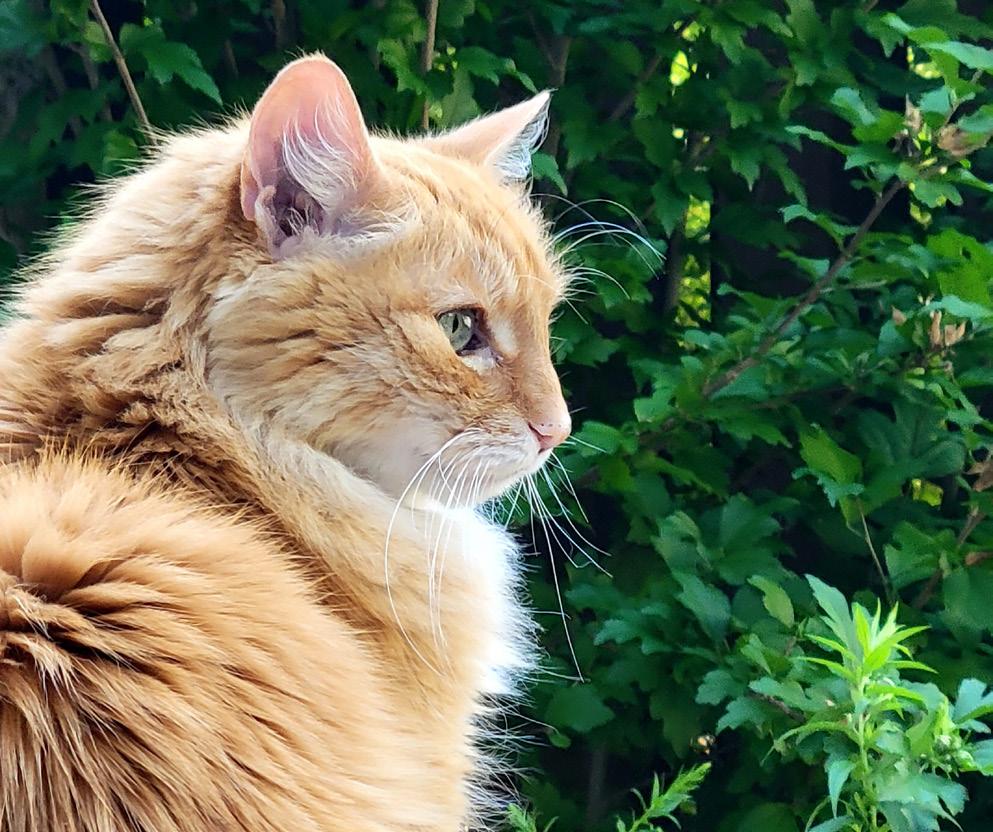
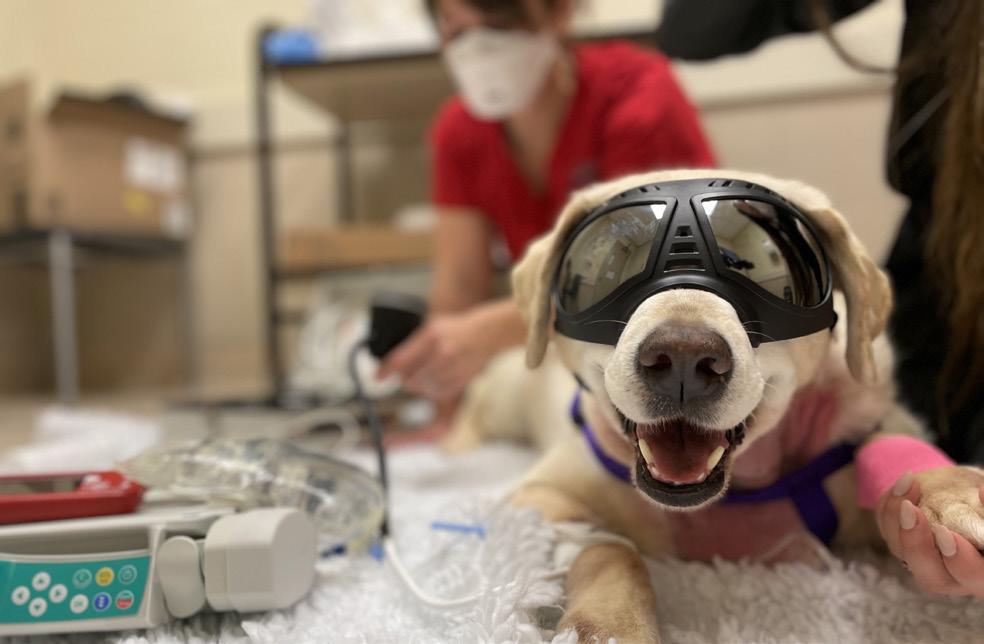

3 4
THE DESK OF OUR DIRECTOR A DAY IN THE LIFE OF THE OVC NEUROLOGY SERVICE ZIGGY’S STORY FROM NOSE TO “TALE” OBESITY PREVENTION STARTS AS A KITTEN TUMOUR TECH GETS LIT SAYING GOODBYE: LILAH’S LEGACY GETTING TO KNOW... DR. ALEXA BERSENAS YOUR GIFTS AT WORK SIX DEGREES OF SEPARATION OVC PET TRUST LAUNCHES INSTAGRAM 2 14 20 ZIGGY’S STORY WHAT PET OWNERS NEED TO KNOW ABOUT PACEMAKERS 10 BEST FRIENDS: THE PET MAGAZINE OF THE ONTARIO VETERINARY COLLEGE 12 10 IN THIS ISSUE: 16 BACK COVER PET TRUST PALS FALL 2022 / WINTER 2023 5 A DAY IN THE LIFE OF THE OVC NEUROLOGY SERVICE 22 26 27 5 16 18 TUMOUR TECH GETS LIT OVC TRIALS NEW TECHNOLOGY TO ILLUMINATE AND DESTROY TUMOURS On cover: OVC cancer patient Miya. Photo credit: OVC Clinical Trials.
FROM THE DEAN OF THE ONTARIO VETERINARY COLLEGE FROM
FROM THE DESK OF OUR DIRECTOR
OVC Pet Trust is more than just an organization. It is a place that is fuelled by the passion and synergy created when the people who care for pets and the people who care about pets come together to do good for animals.

With the generous support of our donors and partners, OVC Pet Trust invests in translational medicine, clinical trials and research projects that are at the forefront of discovery to find answers to complex health issues. The work that happens here has the potential to advance both animal and human health. And, most recently, we are making strides in breaking down barriers to open access to veterinary care to our most vulnerable communities.
Pet ownership is growing at an incredible rate and the veterinary profession is being challenged to keep pace with demand, while managing the threats of burnout, compassion fatigue and moral injury—the cognitive and emotional response that can occur following events that violate a person’s moral or ethical code. We live in a world that is more complex than ever and the needs of our pets and the needs of the people who love them and care for them have undergone a dramatic shift.
You may read more about our strategic vision to fuel innovation, pursue excellence and strengthen connection in OVC Pet Trust’s new five-year strategic plan. Thank you for your support of OVC Pet Trust now and into the future.
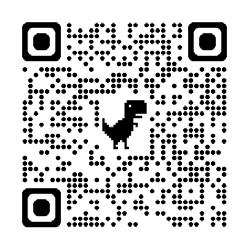
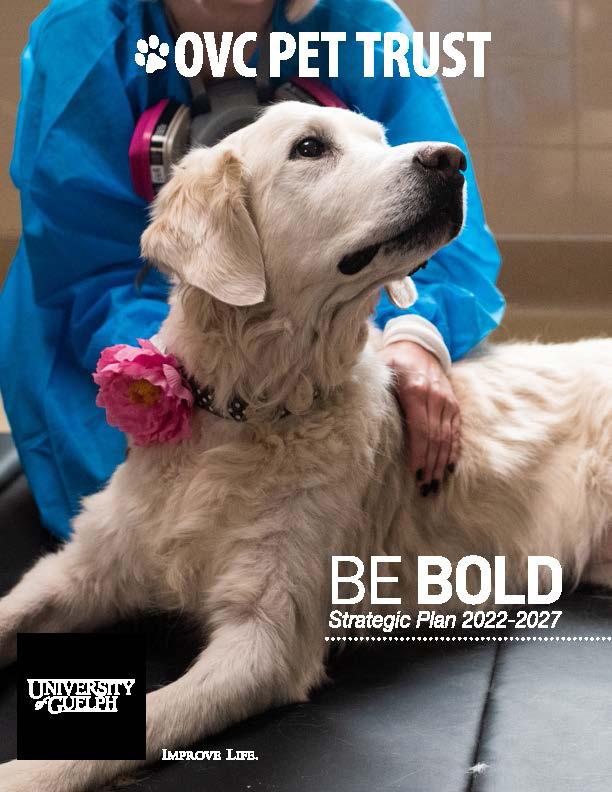 Robinson Director, OVC Pet Trust Ontario Veterinary College University of Guelph
Robinson Director, OVC Pet Trust Ontario Veterinary College University of Guelph
Investments in companion animal clinical research and discovery through OVC Pet Trust directly contribute to the Ontario Veterinary College’s leadership position in veterinary science and our institutional ranking as first in Canada, third in North America and fifth in the world. As we look ahead to the next five years, we know there will be challenges, but we are empowered and ready to Be Bold and address them. Read more about OVC Pet Trust’s strategic vision to fuel innovation, pursue excellence and strengthen connection by scanning the QR code or on our website at uoguel.ph/OVCPetTrustStrategicPlan
Kim
In photo: Kim Robinson and Harley
BE BOLD: OVC
2022-2027 4
Pet Trust shares new Strategic Plan
A Day in the Life of the OVC Neurology Service

Clinician and scientist Dr. Fiona James sits at her computer, poring over an electroenceph alogram—a type of test that measures brain activity—of one of her canine patients. Rows of brightly coloured squiggly lines on the image, paired with a video recording of the dog’s activities, reveal a particular type of activity in the brain accompanying the frequent facial twitches, suggesting that these are caused by seizures. This diagnostic test is one of many James will review this week, each one unveiling critical insight into how a seizure—an unex pected, jarring episode for some patients, or an unfortunately routine occurrence for others —affects her patients. One day, James hopes to be able to pinpoint the precise location that a seizure occurs in the brain of her four-legged patients—and maybe even cure their epilepsy altogether. That’s the goal.
In her role as a professor and a board-cer tified neurologist at the Ontario Veterinary College (OVC), James directly contributes to the improvement of pet health, not only for
her clients, but around the world. Specifically, through her research, she aspires to find inno vative and more effective ways to diagnose and treat canine epilepsy.
James is a global leader in the field of veter inary neurology and is a highly sought-after mentor for trainees who travel great distances to complete a neurology residency under her leadership. She is the go-to person for her vet erinarian colleagues to call on for a neurology referral, and she provides guidance to fellow specialists as well. Perhaps most notably, she is one of only a handful of experts worldwide in interpreting awake EEG (or electroencepha lography) brain recordings in dogs—a method for picturing functional states of the brain and measuring electrical activity. This method sets the gold standard for the diagnosis of seizures and epilepsy in people and dogs.
Today, OVC Pet Trust shadows James and her team in the clinic on the Neurology Service within the OVC Health Sciences Centre.
Dr. Fiona James studies comparative epilepsy, the field of veterinary neurology focused on the similarities and differences between humans and animals who experience the disease. She works extensively with mentors and collaborators at Toronto’s Hospital for Sick Children (SickKids) in her quest to better understand canine epilepsy.
Photo credit: Spencer McMillan.
5
DAY ONE
0730
Case review of the day’s appointments is underway between neurology residents (trainees working to become board-certified neurologists) Drs. Gibrann Castillo Escotto and Stephen Everest. This morning will include three new patient appointments. The team diligently prepares their surgical plan for an upcoming procedure for a dog named Toby, plotting their path on the medical imaging. James guides the team with case management and maps out the tentative schedule for their day on the clinic floor.
To be a good neurologist, you must have a good understanding of magnetic res onance imaging, or MRI—a medical imaging technique that creates detailed pictures of organs and tissues in the body. Neurologists constantly read and interpret MRIs. They tell a story—important details that are vital to understand what’s going on with their patient and how they may be able to help them.
0900
Castillo’s first appointment of the day is a Shar Pei who has been referred to OVC by their family veterinarian because of changes in behaviour that are suspected to be neurological in nature. Castillo begins to build a list of suspected causes for his patient’s condition. In medicine, generating a differential diagnosis list (DDx) is a method of clinical reasoning when physicians analyze a patient’s history, clinical signs or symptoms, physical examination and imaging results to prioritize the most likely diagnosis or cause of illness or disease.
Everest’s first appointment is a 13-year-old Wheaten Terrier named Bentley. After taking a complete history with Bentley’s family, Everest brings Bentley to the treatment room and examines him, performing a complete neuro logical (or “neuro,” in hospital lingo) exam. Bentley has been previously diagnosed with a tumour in his brainstem, the connection between the brain and the spinal cord. Everest and James examine Bentley’s prior MRI images and confirm that radiation therapy is the best treatment option for Bentley’s cancer, which his owner wants to pursue.

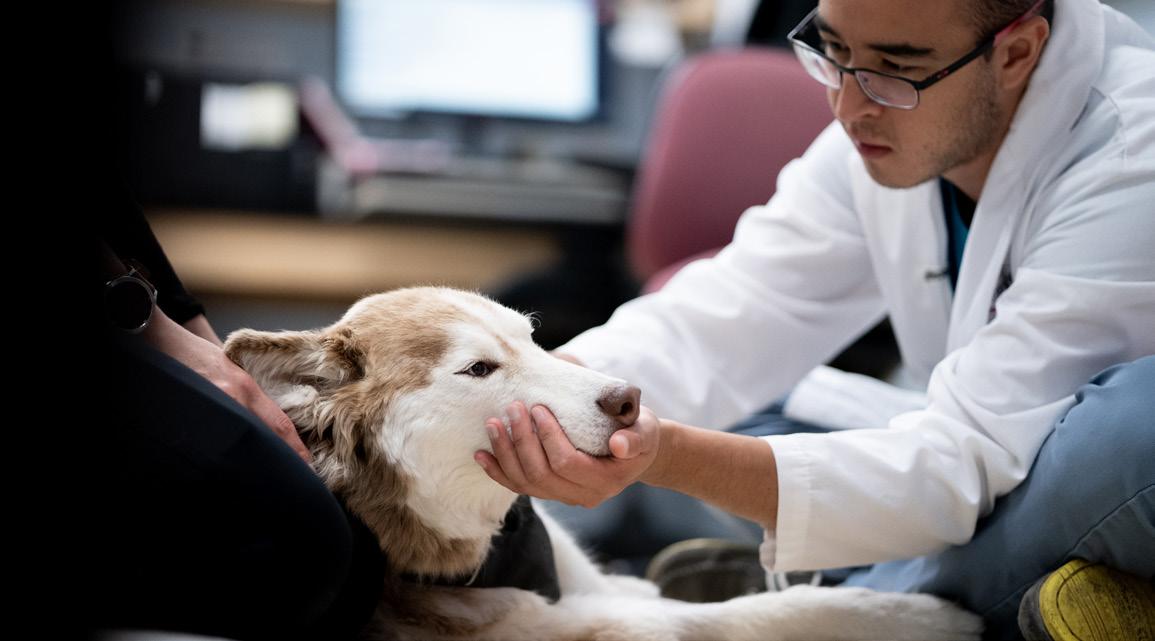

While Everest reviews options with Bentley’s human, Castillo arrives with a two-year-old Husky named Tahoe. Castillo verbally presents Tahoe’s history and exam results to James, who picks up a marker and jots down possible differentials on the treatment room whiteboard to narrow down how the team can help Tahoe. She asks the team: “What are our next steps? What diagnostic imaging do we need to consider to learn more?”
The problem solving continues, and each patient is a puzzle for the team; the more information they have, the better job they can do at placing the puzzle’s pieces into the correct arrangement to form a complete picture.
0930
The day is in full swing as James reviews the MRI of a three-year-old Bulldog with a brain mass and consults with a rotating intern, Dr. Erica Fox, about the case. Discussion is centered around the history of the patient and clinical signs the dog is presenting with, including vision loss. The OVC HSC is a teaching hospital, and James asks Fox which tests she would recommend pursuing to assist in their investigation, which will involve internal consults with ophthalmology and oncology. At the same time, a new dog patient arrives in the treatment room, and a Doctor of Veterinary Medicine (DVM) student—one of five students on their neurology clinical rotation this week—presents the patient’s history to the neuro team. DVM students help monitor neurology patients who are at the OVC Companion Animal Hospital throughout the day, propose diagnostic tests and treatments, update clients about their pet’s progress and write medical records entries—all activities that provide them with clinical experiential learning opportunities in their fourth and final year of veterinary school.
6
Dr. Fiona James performs a hemilaminectomy—a type of spine surgery to relieve back and leg pain—on dog patient Toby at the OVC Companion Animal Hospital. Photo credit: Ashleigh Martyn.
Patient Tahoe is examined by neurology resident Dr. Gibrann Castillo Escotto. Photo credit: Spencer McMillan, spencermcm.com.
OVC Neurology patient Bentley. Photo credit: Spencer McMillan, spencermcm.com.
If the body was an organic computer, James compares the neuro system as the wiring—a system of elaborate and connective networks.
Neurolocalization is an essential tool for neurologists. In simple terms, it means being able to localize—or pinpoint— the area of the nervous system responsible for disease or disruption. The nervous system is a complex network of neurons (specialized cells) that enable parts of the body to communicate with one another; the body’s central nervous system (CNS) includes the brain and the spinal cord. The pathways of the nervous system are not continuous, but they’re intricately integrated, like millions of baton runners during a team relay race—sometimes it’s a single pass or multiple ones to complete the race (or circuit, in the case of neurons in the body), James explains. In the bodyas-a-computer analogy, the spinal cord is the internet, relaying messages and information throughout the body. A neuro exam attempts to answer one pressing question: where have the wires been cut?
James shares that she had been training as a biophysicist specializing in neuroscience because of her fascination with the computational structure of the brain when she discovered the joy of working with animals, which led her to pursue her career in veterinary medicine.
1130
Castillo assesses a dog patient named Bear, an internal consult from the med icine service. If an animal is on pain medication, clinical signs can be masked during a neuro exam, he explains. Everest is on call this week, which means that in addition to his 10-to-12-hour days as a resident, he may be paged any time between the hours of approximately 6 p.m. until 8 a.m. for a neurology emergency. This may include a patient that’s having uncontrollable seizures or MUE. MUE stands for meningoencephalomyelitis of unknown etiology; it is an umbrella term describing inflammatory changes in the central nervous system with no suspected infectious cause in dogs, cats and even humans. MUE refers to inflammation of the brain and the surrounding fluid and tissues and is sometimes caused by an underlying autoimmune condition.
1300
James checks in on a student in her lab, Grace, who is working on an OVC Pet Trust-funded project examining the anatomy of brains of dogs who have epilepsy. Her project involves investigating the differences in connectivity — the wires and the pathways—on MRI to answer a simple question: if pathways are disrupted, does it affect whether a dog responds to treatment or not? Other projects within James’ lab examine the cases of dogs who do not respond to anti-seizure drugs with a goal to answer questions, like: Can we target a better treatment? Is there a way to identify severity of the disease, or a crystal ball to predict disease outcomes to help pet owners make decisions and find peace of mind?

James says that veterinary medicine is not good at localizing the origin of a seizure yet. “The ultimate goal of my research is to be able to very accurately pinpoint the location of seizures so we can consider surgery,” James says.

What is the value of knowing where a seizure occurs in the brain?
James explains that in humans, seizures (and specifically where seizures start) can, in some cases, be precisely located in the brain, and surgery may sometimes be an option to remove or disconnect that part of the brain in an effort to reduce seizures. We don’t do this much in dogs yet, but it’s a technique that, in people, can be curative. Human epilepsy also has more specific sub-types of the disease, such as frontal lobe epilepsy or temporal lobe epilepsy. In dogs, there is just epilepsy (generalized or focal).
7 1000
Neurology resident Dr. Stephen Everest checks on patient Ruger in the OVC Intensive Care Unit. Photo credit: Ashleigh Martyn.
Part-time OVC PhD student Charly McKenna prepares Jackson for an EEG to measure the electrical activity of the dog’s brain. Photo credit: Ashleigh Martyn.
So what does this all mean?
“Better diagnosis leads to a better treatment plan,” James states. “In the grand scheme of things, what we know is proven to help humans may help dogs. What we know about dogs may help humans too. If we can bring dog epilepsy to the human level of diagnosis and treatment, our two-way exchange between species will be strengthened,” she adds, pointing to her research collaboration with The Hospital for Sick Children (SickKids) as a key part of her mission to better understand canine epilepsy.

1400
The afternoon is underway with a follow-up appointment for a Golden Retriever named Lucy. OVC intern Dr. Makayla Farrell presents a new case to the neuro team. Most of the afternoon is filled with paperwork and evalua tion of incoming referral requests from family veterinarians whose patients require the help of a neurology specialist.
1730
Rounds are complete for today, and James finishes them off with an impromptu pop quiz, pulling up radiographs, or X-rays, of a patient with a brain infection. “These are the details you’ll need to know for board certifica tion,” she says to her residents. Rounds, an essential component of medical education, is a collaborative process when the team gathers and shares information about each patient’s condition, status and care plan. The discus sion—and the teaching—is non-stop. The rest of the evening will include paperwork, medical record writing and prescription refills for patients.
DAY TWO 750
Everest examines Ruger in the hospital’s Intensive Care Unit (ICU), a dog who was admitted to the unit overnight while Everest was on-call. Ruger’s owners noticed his behaviour was unusual, and last night, he was suddenly unable to walk and became completely paralyzed in all four of his limbs.

Days like today are an example of how the team delicately balances emer gency patients and scheduled appointments and procedures. Today is Toby’s surgery; Ruger will have an MRI; and another patient named Oscar will have a spinal tap to rule out the presence of cancer cells or inflammation in his cerebrospinal fluid (CSF). CSF is the clear liquid that flows around the brain and the spinal cord in all animals and humans, acting as a cushion to protect the organs from injury or sudden impact. The purpose of a spinal tap is to analyze a patient’s CSF to help make a diagnosis; it can detect conditions like infection, cancer, tumours and other disorders.
1000
Patients are managed as a triage Registered Veterinary Technician (RVT) asks about another potential emergency arrival of a dog with back pain to the ICU. Castillo performs a neuro exam on Lainey, a cat, who is here for a recheck after being hospitalized the prior week with suspected cutere briasis, a parasitic disease. Jackson, a dog, is here for an EEG to diagnose suspected focal seizures. Gunther, a long-haired Dachshund dog that was previously diagnosed with an MUE, is here today to receive a drug protocol to treat inflammation in his brain. The team also sees a dog patient with possible scoliosis, a rare type of spinal cord disease characterized by a curve of the spine.
8
Toby is prepared for surgery in the OVC Companion Animal Hospital’s Kim and Stu Lang Anesthesia and Pain Management Unit. Photo credit: Ashleigh Martyn.
Everest reviews an MRI of one of his patients. Photo credit: Spencer McMillan, spencermcm.com.
Toby is prepared for surgery, anesthetized and wheeled into an operating room (OR) as RVT Jayme prepares Oscar’s spinal tap materials for Castillo.
1142
Everest and James scrub into Toby’s neurosurgery. While some neurosurger ies can be upwards of six hours in duration, the team is hopeful that Toby’s will take approximately three hours from start to close.
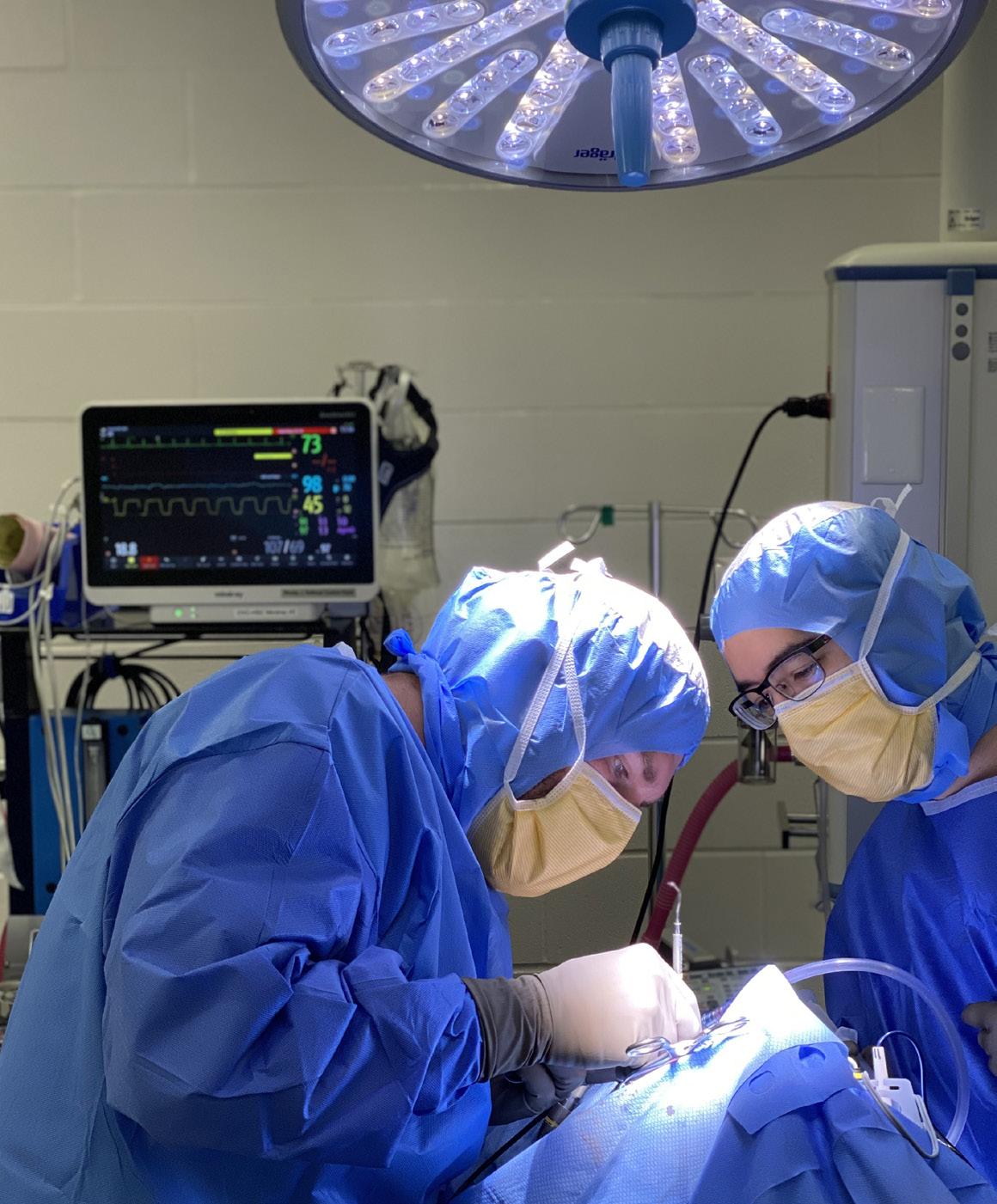
1245
Surgery is well underway and Castillo has joined Everest and James in the OR. An intern comes in to consult with Castillo about a dog that has been admitted to the ICU who is experiencing uncontrollable cluster seizures —multiple seizures within a short period of time—sometimes life-threat ening. Castillo scrubs out to consult on his patients in the ICU.
1520
Toby is in recovery and as Everest and James return to the treatment room, Castillo presents two new hospitalized cases to them. One of those cases is Abby, a Cocker Spaniel dog, a patient who has been admitted to ICU with suspected bacterial meningoencephalitis, inflammation of the brain and spinal cord caused by an infection, which the team suspects may be causing focal seizures and other life-threatening clinical signs.
1700

Rounds today involve discussion about the patients in neurology’s care —both inpatients — animals that are currently hospitalized—and outpatients too: Toby, Lainey, Oscar, Jackson, Ruger, Abby and two other dogs. Everest prepares for an after-hours neurosurgery for an incoming emergency patient.
Throughout the whirlwind of exams and consultations, procedures and follow-ups, James remains a steady and calming presence in what can sometimes feel like the frenzy of it all. She is a passionate and accomplished teacher—mentoring, guiding and pushing her trainees and students to prepare them for a future in the specialty of neurology and general practice while providing thoughtful and compassionate care to their patients.
“It is incredibly satisfying to have the opportunity to try to solve a clinical problem after identifying it—whether it is for patients and their families, or on a grander scale designing studies to probe the bigger issues,” James says. “On top of that, the delight of seeing a trainee put it together for the first time and have that ‘ah-hah!’ moment is so rewarding,” she smiles, adding that she is reminded daily how much we still have to learn about the nervous system – it’s all part of the beauty and intrigue of constant progress and innovation in pursuit of discovery as a scientist.
“Neurological problems can be scary and intimidating because we can’t see the cause, not like when you have a broken leg. Similarly, that first seizure you ever see seems to take forever to stop. But not all the causes and diseases are bad; many can be managed with a decent quality of life. Neurologists often find themselves recommending ‘time’—to give our pet friends a chance to heal,” James says.
9 1107
Everest and Castillo in surgery. Photo credit: Ashleigh Martyn.
Neurology patient Abby is monitored in the OVC Intensive Care Unit. Photo credit: Ashleigh Martyn.
ZIGGY’S STORY

10
In photo: OVC cardiology patient Ziggy.
Heading into the family day weekend this past February, Ziggy was not his regular, active self. The 12-year-old Domestic Longhaired cat—who is usually affectionate and energetic—was sluggish and hiding from his owners, Caitlin Hayward and Kevin Procter.
“Ziggy is the kind of cat who will come and greet me after a stressful day of work and try to take care of me,” says Kevin. “Hiding from us was very unusual be haviour, so we knew something was wrong with him.”
On the Friday afternoon before the long weekend, Ziggy began having periods where his body would get suddenly rigid and then collapse, and his family vet erinarian recommended an urgent trip to a specialist. So, first thing on a snowy Saturday morning, Caitlin and Kevin brought Ziggy to the University of Guelph’s Ontario Veterinary College (OVC).
“When we dropped Ziggy off for an examination in Guelph I was devastated,” says Caitlin. “Every time he would collapse, he seemed so terrified. It was terrible seeing him distressed.”
Ziggy’s veterinary team at the OVC included Dr. Shari Raheb, assistant professor and board-certified veterinary cardiologist; and Dr. Ananda Pires, veterinary cardiology resident. They diagnosed Ziggy with an atrioventricular block – which meant that the electrical activity at the top of his heart was not getting to the bottom of his heart to pump blood around his body. This block was causing Ziggy’s collapsing episodes, which became more frequent as the weekend progressed.
The veterinary team determined that Ziggy would need a pacemaker—a surgically implanted medical device that helps to control irregular heartbeats—to resolve his condition.
“Much like pacemakers used in human medicine, veterinary pacemakers sense the heart beating and paces it when a beat is not detected,” says Raheb. “To install the pacemaker, Ziggy needed surgery. It’s a major procedure that needs a large team of surgeons, cardiologists and anesthesiologists.”
At first, the team regulated Ziggy’s condition with medication. But as the weekend progressed, Ziggy’s collapsing episodes became more frequent, and the medication was not working to control them. Ziggy needed a pacemaker immediately.
“When they told me that Ziggy needed a pacemaker, I was shocked,” says Caitlin. “I didn’t even know cats could get pacemakers.”
Pires and Raheb assured Caitlin and Kevin that Ziggy was a good candidate for the surgery based on his age and otherwise good health.
“We were unsure about the procedure, but after the care team explained that Ziggy would live out a healthy and normal life, the decision to get him the pacemaker was a no brainer,” says Kevin.
Ziggy was rushed into the hour-long surgery on Family Day and spent the next few days recovering in OVC’s Intensive Care Unit. Caitlin and Kevin were in touch with the veterinary team until they finally picked him up to go home.
“Dr. Pires was amazing. She called us two to three times per day to update us on Ziggy’s condition, and even sent us a video of him when he got out of surgery,” said Caitlin. “Every step of the way she was never too busy to talk with us and keep us informed on Ziggy’s progress—this really took a weight off our shoulders during a very stressful time.”
After a few weeks of rest and recovery, Ziggy was ready to start climbing, playing and running like he used to. Now, almost six months post-operation, Ziggy is back to his normal self. In fact, Kevin says that Ziggy is more energetic and playful than he ever has been.
“It’s like he’s a kitten again!”
Ziggy’s care team says that his pacemaker is working exactly as it should to keep his heart beat regular, and he has been doing very well since the surgery. He is set up to live out a happy and healthy life, and aside from occasional pacemaker check-ups, Ziggy does not need any special or ongoing care.
“The OVC team was amazing—we were so im pressed,” says Kevin. “If it hadn’t been for them, Ziggy wouldn’t be with us today.”
pacemakers
• A pacemaker is a medical device that regulates an abnormal heartbeat.
• Pacemakers are surgically implanted, and the procedure can take one to two hours.
• Cats that receive pacemakers may be able to live out long and healthy lives.
• Your veterinarian, along with a veterinary cardiologist, can help you determine if your cat is a good candidate for a pacemaker based on age and health.
11
What pet owners need to know about
FROM
NOSE TO “TALE”
Year over year, your pet’s annual wellness check tells a story
Regular veterinary care helps maintain your pet’s overall health— but just how important is that yearly physical exam when your pet’s health status seems unchanged?

12
While it may feel tempting to skip the annual exam if nothing seems off, research suggests regular physical exams each year help identify health problems early, improve relationships between pet owners and veter inary care teams and make owners feel more open to their veterinarian’s recommendations.

Dr. Judith da Costa, who completed her Masters of Science with Dr. Jason Coe, professor and VCA Canada Chair in Relationship-Centred Veterinary Medicine at the Ontario Veterinary College, focuses on standardizing annual veterinary physical exams and improving how veterinarians discuss the exam with clients.
“There’s a lot we don’t see that is important to our pets’ health, and it’s an animal’s instinct to hide it when they are unwell,” says da Costa. She notes 72 per cent of wellness appointments she studied, where the pet was assumed healthy, the veterinarian identified at least one medical concern during their physical exam that was previously undetected by the owner.
YES, THAT WAS THE EXAM
The physical exam is a central part of companion ani mal health care appointments, but when surveyed after their appointment, previous research out of the United States shows that many pet owners did not realize a physical exam took place. That may be because the vet erinary physical exam may look to a pet owner like the veterinarian is simply showing the cat or dog some love.
“Sometimes both the veterinarian and client get distracted and start talking about other things, and the client isn’t necessarily aware of what the veterinarian is doing,” da Costa says. “In a physical exam, a veterinarian starts with the nose and works their way down to the tail—the entire patient is examined.”
During the exam, your veterinarian is diagnosing through touch —feeling for tumours, lymph nodes and swelling. They are checking pulse quality, evaluating mucous membrane colour and examining body condi tion to check if the pet is under or overweight. They do this by feeling various body parts and using instruments such as a stethoscope to listen to the heart, an ophthal moscope to check eyes and an otoscope to check ears. Veterinarians also make comparisons such as compar ing heart rate to pulse rate to check for “skipped beats.”
PROBLEMS START EARLIER FOR OUR PETS
Cats and dogs do not live as long as humans, and that means age-related problems develop sooner. Da Costa says health problems that may be more common in old er people, such as kidney failure or thyroid disease, may come into play much earlier in the life of a dog or cat.
“If there’s a problem, it’s always better to address it early—that’s why the physical exam is so important,” says Coe. “It gives us the opportunity to pick things up. The sooner something is diagnosed, the better the outcome, in most cases.”
NORMAL IS A BASELINE
Every pet’s lifestyle is different, and pet owners have an important role to play in communicating what their pet’s living environment and typical day is like. Changes in routine are just as important to note.
“If a cat has a favourite spot they sleep in during the day, and now they’re hiding or not going to that spot, you should mention it,” says da Costa. “If a dog is waking up at a different time, or if they don’t bark at the thing they used to, or if there’s a change in their appetite, some thing may be going on.”
And, even if a pet’s behaviour, lifestyle and health status seem unchanged from last year, they should still be examined annually. Da Costa says normal status pro vides important baseline information to identify when something goes sideways.
ASK YOUR QUESTIONS UP FRONT
There is only so much time allocated for a veterinary appointment, so if you have a concern, do not wait for your veterinarian to bring it up. Da Costa suggests clients should write their concerns down before the appointment and raise them at the beginning.
“When your veterinarian is examining your pet, it’s a great time to focus on what they’re doing, and ask ques tions to become more involved,” says da Costa.
THE VALUE OF COMMUNICATION
Creating two-way open conversation is important when interacting with any healthcare provider. This is a shared responsibility of both the veterinarian and the pet owner. What if your veterinarian makes a recommendation that you are not comfortable with? “For example, if your veterinarian prescribes a pill for your cat twice a day and you know there’s no way that’s going to happen, you need to be up front about that and come up with a different solution together,” says da Costa.
She notes that by talking through a physical exam and focusing on the pet, both the client and the veteri narian have an opportunity in working together to create appropriate care plans and in understanding next steps.
“When veterinarians take the time to talk through the physical exam, the client has a better opportunity to understand the significance of the findings, and to understand why it may be important to intervene right away,” da Costa says. “The more pet owners under stand the reason for examining each component of the physical and the impact of those findings, the more information they have about their pet’s health status and thus the better equipped pet owners are for making good treatment decisions, which likely results in better quality and quantity of life for their pet.”
Dr. Judith da Costa is currently the Chief Veterinarian at Toronto Animal Services, Municipal Licensing and Stan dards at the City of Toronto. Learn more about the team’s research at uoguel.ph/AVMATalkingPhysicalExam.
13
Photo credit: istock.com/T Turovska
Obesity prevention starts as a kitten
One nutrient’s promising role in feline weight management
Choline: noun – /kōlēn/ – An essential nutrient found in foods like eggs, meat and grains that helps with important processes like fat metabolism and transport. Cats do not produce enough choline to survive, so this nutrient must be obtained through food.
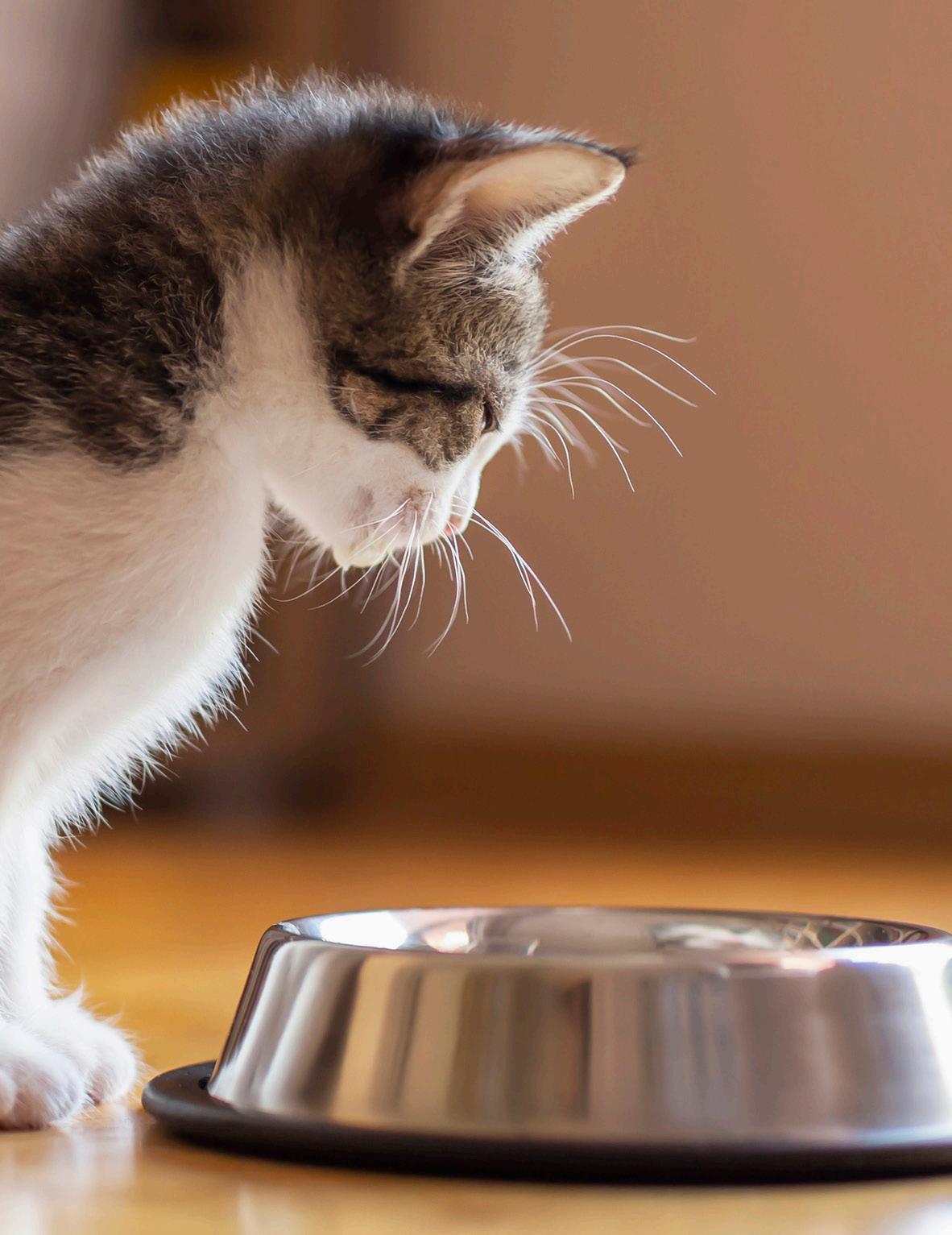
14
Taking good care of a kitten’s health sets them up for healthy adult years and a long happy life—and this is especially true when it comes to weight management. While a cat’s healthy weight can be achieved with a balanced diet and exercise, a study at the Ontario Veterinary College (OVC) — recently published in PLOS ONE and led by board-certi fied veterinary nutritionist, Dr. Adronie Vebrugghe, associate professor and Royal Canin Veterinary Diets Endowed Chair in Canine and Feline Clinical Nutrition, and PhD candidate, Hannah Godfrey—has found a promising new way to help pet owners avoid kitten obesity issues.
Feline obesity, or excess body fat mass, is a major health concern that can cause many health complications such as diabetes mellitus, osteoarthritis and urinary tract disease— to name a few.
The research team investigated a nutrient called cho line—an essential vitamin-like nutrient for many animals and humans that occurs naturally in certain food—to see if it could help kittens after they had been neutered maintain a healthy weight as they develop.
What is feline obesity?
Cats can become obese if they are fed too much and live an inactive lifestyle, but another major risk factor for excess weight gain is also the spay/neuter process— where veterinarians surgically remove a cat’s sex organs to prevent breeding.
“It is very common and highly recommended to neuter house cats, and there are lots of benefits of this process for the cat,” says Godfrey. “But, desexing may reduce a cat’s activity levels and increase appetite which can put them at a greater risk for weight gain.”
Godfrey says another risk for obesity is excess fat mass during kittenhood. “Kittens that carry extra fat mass while they are growing are more likely to have weight problems as they age,” says Godfrey. “We wanted to investi gate if supplementing a kitten’s diet with choline would be beneficial in their growth phase to prevent obesity.”
What is choline?
Choline is an essential nutrient that has many roles in the body and can be found in food like eggs, meat and grains. Godfrey says that choline must be pres ent in a cat’s diet to help them grow and develop normally, so cat food companies add a choline supplement to their products. The absence of choline in the diet will not only impair growth and cause neural defects during growth, at any age it can also cause storage of fat in the liver, which could be deadly.
Although industry standards recommend that cat food contains a minimum nutrient requirement, choline levels are relatively low in many popular products and Godfrey says that choline intake above these low levels may pro vide additional benefits for kitten growth and health.
Choline and weight management
To see the benefits of a choline-rich diet, the research team studied neutered male kittens for 12 weeks. During the study period, all kittens were fed their regular food but half of the kittens were provided with a choline supplement.
The kittens were regularly weighed and scanned using dual-energy x-ray absorptiometry, also known as a boned ensitometer, to see how their growth rates, lean masses and fat masses changed. The team also watched the kittens’ food intake and energy output, finding that the cats who were given additional choline ate less food and gained less body fat while still developing at a normal rate in accordance with kitten growth charts.
The takeaway for cat owners
The study results show that choline could help kittens maintain a healthy weight. However, these findings do not suggest that choline is a magic bullet for obesity prevention, and Godfrey cautions pet owners against changing their cat’s diet without talking to a veterinarian.
Keeping
your
kitten’s weight under control
“There is currently no supplement form of choline for obesity prevention available for purchase at pet stores, so these findings do not directly impact pet owners,” explains Godfrey. Instead, she says that future research can build on these findings to ultimately help the pet food industry to combat the feline obesity epidemic.
1. Ensure your kitten is getting enough exercise. Make sure your kitten has enough toys and that you play with them daily. Just like dogs and other pets, house cats need to exercise regularly to maintain a healthy weight and build lean muscle.
2. Feed your kitten the right amount of food. Talk to your veterinarian to find out how much food your cat needs every day. Make sure you measure out the right portion size for your kitten and be careful not to give them too many treats.
3. Help your kitten eat slowly. Try out food toys or puzzles that prevent your kitten from eating too quickly.
4. Weigh your kitten often. Frequent check-ups can help make sure your kitten is growing well. If you notice your cat is gaining too much weight, your veterinarian can help you get them back on track. Also kitten growth charts are very helpful to keep track of your kittens growth.
Although a definite recom mendation for choline cannot be made until more research is done, for now, kitten owners can keep their furry friends healthy by making sure they get enough exercise, eat the right amount of food and have frequent veterinary check-ups.
This research was made possible by generous support from the Natural Sciences and Engineering Council of Canada, Elmira Pet Products and in-kind contributions from Balchem Corporation. Funding for the acquisition of the dual-energy x-ray absorptiometry scanner was provided by the Canadi an Foundation of Innovation and the Ontario Ministry of Research and Innovation.
15
credit: istockphoto.com/vladans
Photo
TUMOUR TECH GETS LIT
OVC TRIALS NEW TECHNOLOGY TO ILLUMINATE AND DESTROY TUMOURS
Weeks before her dog Miya’s cancer diagnosis, Liz Pietrzak noticed some changes in the 10-year-old Labrador retriever’s behaviour. Miya seemed to be panting more and seeking out cooler, drafty areas to rest. And the usually “chunky” dog, who Pietrzak describes as “one of those butterball labs,” had lost some weight.
Miya’s veterinarian ran some tests and called Liz to give her the news. “She said, ‘we found something, and we think it’s cancer,’” Liz recalls. “Miya never had anything wrong with her until then.”
Miya was diagnosed with thyroid cancer and referred to the Ontario Veterinary College (OVC) for treatment. OVC’s standard of care for thyroid tumours involves surgery to remove the tumour, but Pietrzak was notified of an additional opportunity: an OVC research team was seeking ten dogs to participate in a clinical trial to evaluate a new medical treatment for cancerous tumours in companion animals. The inventors of the technology, partners at the University Health Network (UHN), plan to evaluate this same technology in humans, which may lead to a parallel trial on human thyroid cancer patients. Pietrzak agreed that Miya would be dog number two in the trial.
An innovative “seek and destroy” alternative to cancer surgery for people and pets is being tested for the first time at the University of Guelph’s Ontario Veterinary College (OVC). Combining nanotechnology and laser light therapy, the new technique may ultimately offer a targeted, non-surgical way to diagnose and treat tumours, while preventing overtreatment and reducing common side effects. The promising new treatment has potential to change the way we treat and diagnose cancer in the future, says surgical oncologist Dr. Michelle Oblak.

16
PROMISING NEW TREATMENT TESTING UNDERWAY
The trial is being led at OVC by Dr. Michelle Oblak, surgical oncol ogist and Animal Health Partners Research Chair in Veterinary Medical Innovation, and it combines the use of two medical tech nologies. Together, the treatments offer a promising “seek and destroy” approach to cancer treatment for companion animals as well as humans.
First, a medical team injects tiny particles called porphysomes through an intravenous (IV); the porphysomes circulate through the body and accumulate in tumours. Then, the team uses a specialized camera and near-infrared fluorescence (NIRF) light to make the cancerous cells “glow in the dark” so they are easier to see. Finally, the team uses photodynamic therapy (PDT)—a type of laser—to create a path of destruction within the tumour.
“Porphysomes are multipurpose, because they help with im age-guided surgery and margin assessment, and they also make tumour cells more penetrable to laser light, or PDT,” says Oblak. “We see this treatment having applications for less invasive treat ment approaches in the near future.”

THE PROBLEM WITH CANCER RESEARCH
Although researchers have been working with porphysomes for a decade, this is the first time they are being used on patients with naturally occurring cancer. An estimated 94 per cent of cancer therapies developed using mice models fail to produce effective therapies in humans, but Oblak sees potential in using compan ion animals as models for human diseases and treatments. It’s a branch of research known as ‘translational medicine’ because humans and companion animals have so much in common.
“Our pets have huge genetic diversity, and they live in a shared, complex environment with humans,” says Oblak. “When they de velop naturally-occurring diseases, it presents an almost perfect model for the development of new treatments.”
WHY CLINICAL TRIALS?
Charly McKenna, research manager of the Veterinary Innova tion Platform at OVC, says participants in clinical trials are vital to advancing knowledge and techniques in companion animal medicine. While each clinical trial may look a little different, the approach is always the same: patients have access to the highest standard of care using proven treatments, in addition to new and emerging technologies and therapies. This ensures patient out comes are not compromised as these new treatments are being developed and perfected.
“We want to understand at what point the maximum amount of porphysomes get into the tumour and when the ideal timing of the PDT procedure might be, but we aren’t ready to use this as a treatment just yet,” says Oblak.
McKenna says this study is an example of one that will not nec essarily provide any additional benefit for the current participants, but it will benefit dogs, cats and humans in the future.
“Our study participants are still having their whole thyroid tumour removed, and receiving the full standard of care,” says McKenna. “This is how we learn and further our knowledge, through patient trials, and pet owners who want to participate. We are thankful for families—like Miya’s—that enroll in our studies.”
For Pietrzak, the experience of participating in the clinical trial was a positive one. She feels good about the care Miya—and the whole family—received at OVC.
“The entire medical team took time with us, they answered all of our questions, and sent us messages and pictures to show us how well she was doing,” says Pietrzak.
Miya’s cancer has not progressed to her lymph nodes, and she has made a full recovery.
“Miya is a retired Red Cross therapy dog, and she has always been giving back to somebody, so we thought, ‘why not?’” Pietrzak says. “First, it helped Miya. Second, it will help us all. It furthers our understanding of cancer in dogs, cats and humans. I think that’s amazing.”
For more information about Clinical Trials at OVC visit ovcclinicaltrials.uoguelph.ca.
17
Clinical trial participants like Miya (pictured) are vital to advancing knowledge and techniques in companion animal medicine.
Photo credit: OVC Clinical Trials.
In photo: Dr. Michelle Oblak in the operating room at the OVC Companion Animal Hospital. Photo credit: Scott McQuarrie, scottmcquarrie.com.
Dog of myLilah’sheart Legacy

18 Saying Goodbye
It has been six years since Delilah died from cancer, but for Dianna Beilschmidt, her beloved dog is everywhere.
Each day she wears a locket in the shape of Del ilah’s paw around her neck. Old basketballs—that brought Delilah so much joy to deflate—are still ly ing around the deck for Dianna’s other dogs to play with. In the living room, there’s a framed photo of Delilah as a puppy from the time when she rolled around in a pile of clothes and somehow managed to “put on” a bra, shoulder straps and all.
“She was so silly, and she had so much glee,” Dianna remembers of her cherished Newfound land-Border Collie cross.
For Dianna, her bond with Delilah (lovingly referred to as Lilah) went beyond most dogs. A Type 1 Diabetic since she was 13 years old, Dianna has always had to manage the occasional “crash” that can occur when her blood sugar drops quickly. This often happens while she’s sleeping and unaware of the danger she is in; a source of constant worry for Dianna’s husband Bernie.
While there are diabetic alert dogs who are trained to respond to the odour a diabetic person gives off when their sugars drop too low, Dianna says Lilah was a natural. “After that first time Lilah woke me, Bernie started sleeping better because he knew she was on duty,” Dianna says. “She saved my life more than once, and she rarely left my side.”
A similar episode happened again years later, when Dianna’s blood sugar dropped so low that she began to convulse while watching a movie while alone on her bed. Lilah went to Bernie, who was in another room, and insisted he follow her.
“When a person’s sugar drops, they lose their thought process, and it takes a while to come around. But if I were to convulse and my sugar had kept dropping, I could have died,” she says.
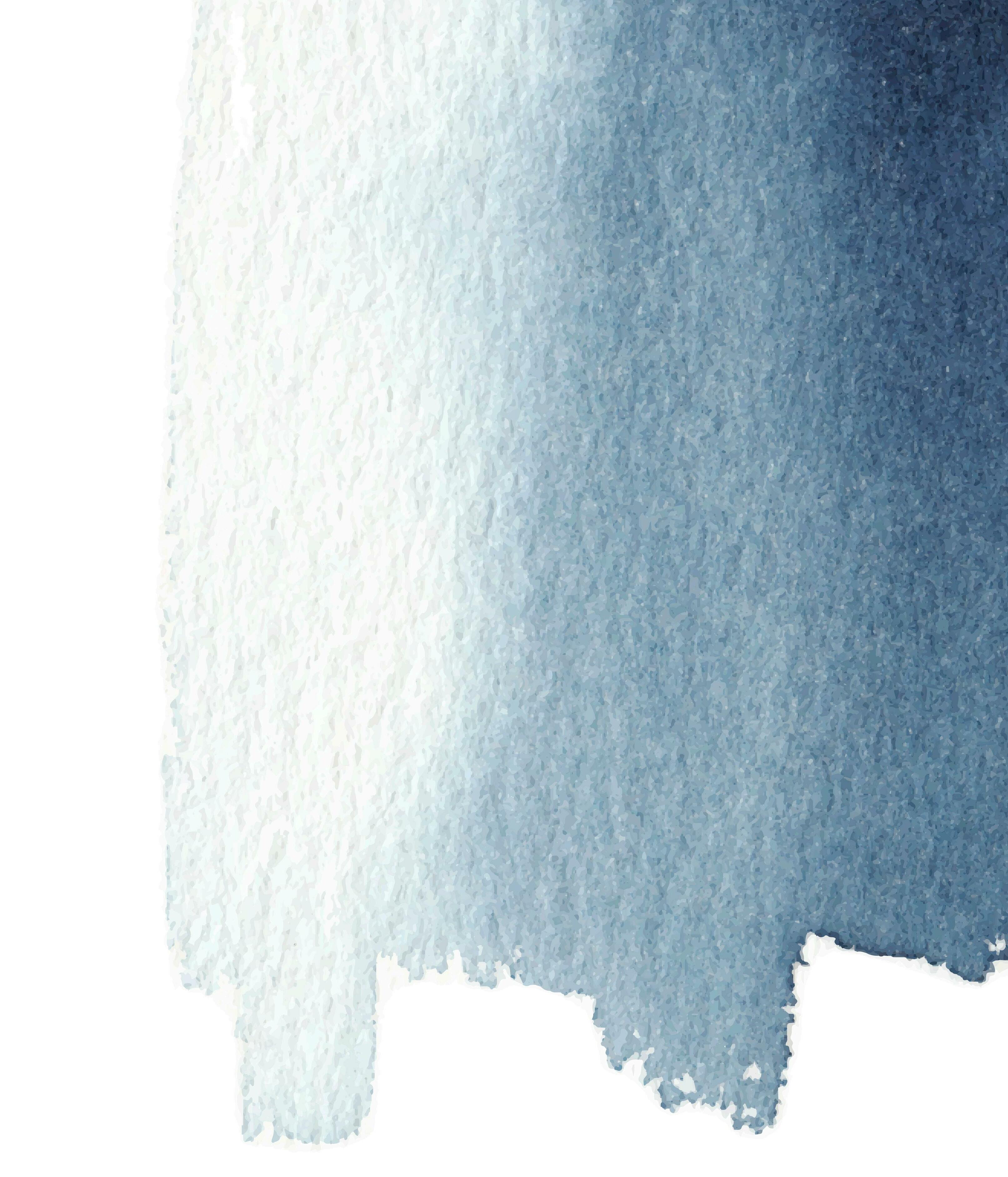
A four-legged guardian
“About a year after Lilah was with us, she was asleep beside me on my bed, when she suddenly woke me up licking my face—she wouldn’t stop,” says Dianna. “I realized my sugar was dropping, and I needed to eat or drink something immediately to bring my blood sugar back to a safe range.”
A legacy of love and life-saving care
Lilah has served as an inspiration for Dianna. She was 12 years old when she passed away after a full and happy life. “If there had been an option to save Lilah when she was diagnosed with cancer, I would have taken it,” says Dianna. “In the end, it was a ruptured spleen that took her life. There was no telling how far her cancer had spread.”
Dianna says what she misses most about Lilah is the way she would yodel at the top of her lungs on the picnic table; the welcome home kisses she gave Dianna every day after work; playtime in her pool on a hot summer’s day; and especially watching tearjerker movies together on the big bed with a tub of popcorn to share. After Dianna lost Lilah, it took her five years to eat popcorn again.
“You could always see the love she had for us in her eyes, and she was the sweetest, most gentle dog you could ever wish for,” Dianna reminisces. “For ever faithful and never a complaint for the many health issues she had to endure.”
Today, Dianna and Bernie share their home with five large dogs and live on a one-acre prop erty in Dunnville, Ontario. “Our dogs and cats are our family” says Dianna. “It’s hard when they get sick. It would be more difficult still if the price of treatment became a barrier to getting them the care they need.”
Over the years, Dianna’s dogs have needed pro cedures to improve their quality of life. Lilah was one of the first in their region to undergo stem cell therapy to manage her arthritis—a procedure she had twice. Dianna’s other dogs underwent several knee surgeries over the years to stabilize the joint affected by cruciate ligament disease.
“For some pet owners, the cost of treatment can be impossible to plan for or manage,” Dianna says. “It’s a lot of money, and some people just don’t have it. But saying goodbye to a pet because of something as simple as a torn ligament? It doesn’t make sense to me.” That’s why Dianna decided to memorialize Lilah and her devotion with a gift in her will to OVC Pet Trust. The gift made in Lilah’s honour will be used to help pet owners cover the costs for veterinary care.
“I love and cherish all my dogs, but Lilah Girl was something special,” says Dianna. “Her legacy will live on. She’s going to help other families keep their beloved pets with them. She was the dog of my heart and every day I thank the good Lord above for sending her to me.”
19
Dealing with and preparing for the loss of a pet can be difficult to navigate. Visit pettrust.ca/petlossresources to access FREE support resources created by OVC Pet Trust.
In photo: Lilah with basketball.
Professor and Criticalist Department of Clinical Studies Ontario Veterinary College University of Guelph
I am one of those people who was interested in veterinary medicine from a very young age. I loved animals and was very interested in medicine. My mother used to always say “you should become a veterinarian” as I entwined myself around whatever creature I could. As a young child, my favourite TV show was Emergency, a fictitious TV show about paramedics. I guess the two collided.
Why did you pursue advanced training and specialize as a veterinary criticalist?
Growing up as a teenager I worked in small animal private practice. My aspiration was to own a small animal prac tice. Once I graduated and started working as an associate veterinarian in such a setting, I realized that this path was not well-suited for me. I felt quite lost learning that what I had dreamed of was now not what I wanted, and I had to really consider what I wanted from my career to make it fulfilling to me. As a veterinary intern, I recognized that I liked and contemplated veterinary neurology, cardiology and surgery but a mentor told me that I if I didn’t know what discipline I wanted I was not destined for pursuing any of these specialties. Then, I learnt of an opportunity in veterinary emergency and critical care, and this was perfect—a little cardio, a little neuro, a little respiratory medicine, a little of everything in a patient that needed my attention. It was an instant match.
What would you want pet owners to know about the field of emergency medicine and critical care (ECC)?
ECC is a very broad discipline that cares for animals in a variety of critical situations: our patient may suddenly be unable to urinate; may have ingested a toxin; may be experiencing dehydration; or even dealing with trauma. It is a discipline that runs 24/7, 365 days of the year. Veteri nary teams who provide ECC want to relieve distress. They recognize the need to provide rapid and precise care due to the urgency of the problem for you and your pet and they want to help. They can help resuscitate an injured animal, provide oxygen and stabilize an animal with respiratory distress and perform life-saving interventions. For exam ple, they can deliver a blood transfusion, perform pericar diocentesis—a procedure to remove fluid from around the heart, they can provide emergency surgery and provide warmth, acute pain management and medical care over night—Monday to Friday or on Christmas Day. Individuals in the field of ECC are devoted to pets’ comfort and care. As a group, these people like a fast-paced, unpredictable environment; multi-tasking is essential and success would not be achievable without a team approach; they also like to feel needed and are rewarded with the success of a recovering patient or the ability to provide end-of-life care.
What research projects are you currently working on?
My research is investigating alternative methods of deliv ering oxygen to pets in respiratory distress, particularly the use of high flow nasal oxygen (HFNC) in dogs. The ability to deliver HFNC to our small animal patients allows us to support patients that would otherwise have required general anesthesia and mechanical ventilation. I am also working on looking at the effects of intravenous fluids (IV) on the resuscitation of cats and dogs. The long-term goal of this current exploratory research is to better understand and optimize the delivery of IV fluids to critically ill vet erinary patients. Similar work is being explored in human patients.
The new ICU facilities will allow for a bigger space for our veterinary care team to function and provide care to our patients. We had outgrown our previous space, becoming exceedingly cramped, and new facilities will afford better space, visibility, improved accommodation of our patients and the equipment for their monitoring, with augment ed infection control. The new unit also accommodates a feline room for the visibility and care of critical cats, removing them from the hubbub of the emergency admis sion area and noise of our canine patients. The new space frees up an area specifically for emergency admission and short-term care, an area that has been highly needed with the volume of emergency medicine seen at OVC.

20
Why did you pursue a career in veterinary medicine?
What do the new ICU facilities at OVC mean to you and what benefits will they provide for our patients and our clients? For our trainees and our team members?
Photo: Teddy, a dog patient who was hit by a car, is monitored by Dr. Alexa Bersenas in the OVC Intensive Care Unit. Photo credit: Ashleigh Martyn.
Dr. Alexa Bersenas
There are an incredible number of similar ities to human ICUs. The types of patients, the equipment, the complexity of cases and the ability to provide advanced care can mirror that provided in a human ICU. The ICU at OVC has mechanical ventila tors, dialysis equipment and much more. The ability of our ECC team members can rival the care provided by our Emergency Room counterparts in human medicine. We also highly respect and look to our human ICU colleagues for support, advice and training (when they have not been overwhelmed by COVID).
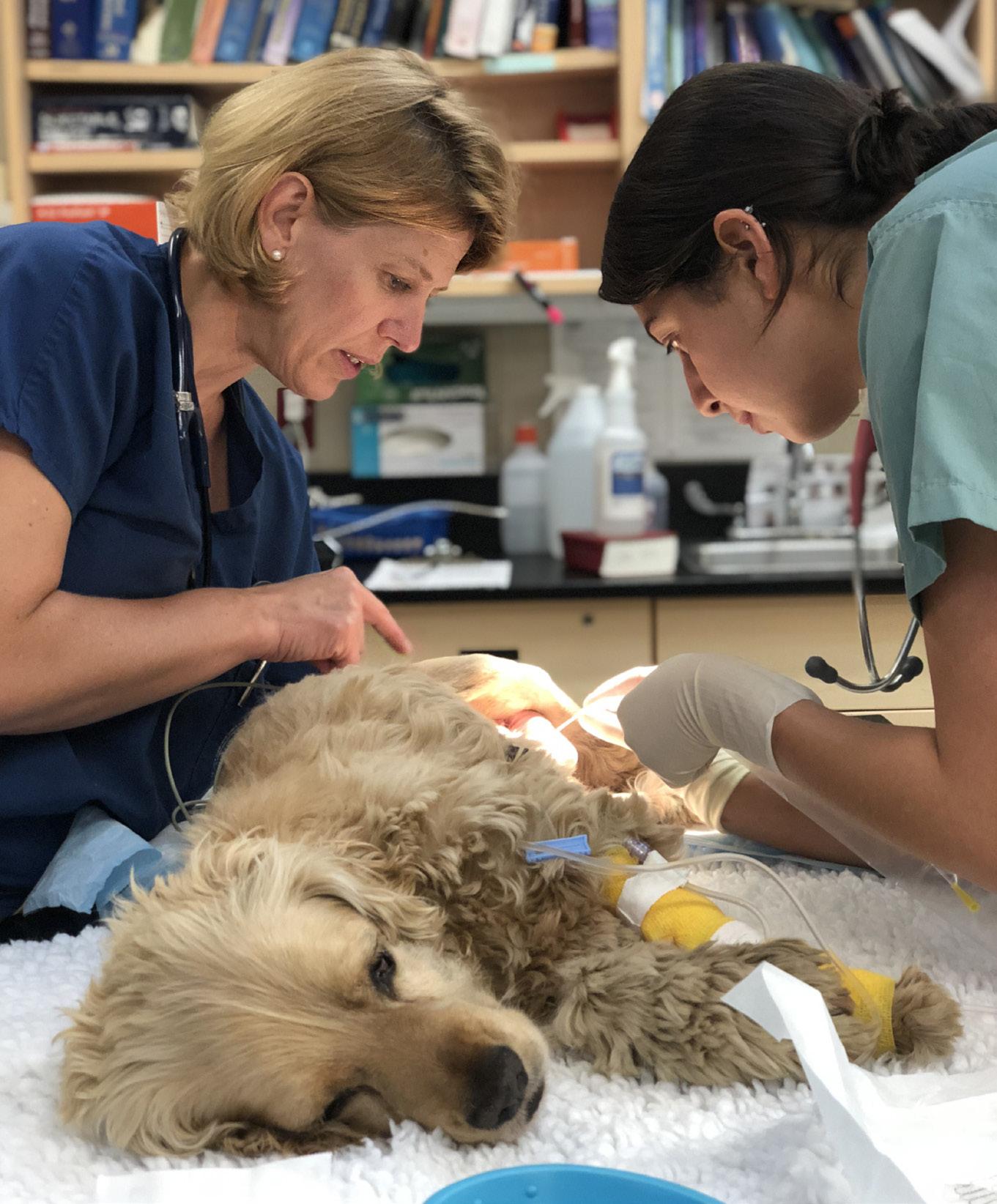

Do you own any animals yourself?
I couldn’t imagine life without a pet. Currently my family owns a 14-year-old Rhodesian Ridgeback who has challenged us for many years with severe separation anxiety. For this old lady, the last two years of the COVID-19 pandemic and having someone at home with her nearly 24/7 has made her ultimately happy and she is currently on the path of simply being spoiled rotten. We also have a ludicrous, super special, very chill, very vocal cat named Leo. He is the apple of our eye in our household.
How does a veterinary ICU compare to a human ICU?
21
Dr. Alexa Bersenas guides the treatment of patient Charlie with OVC intern in the Intensive Care Unit.
Photo credit: Ashleigh Martyn.
Dr. Alexa Bersenas greets former ICU patient Sookie whose life she helped save. Photo credit: Noelle O’Brien.
Each year, OVC Pet Trust invests more than $600,000 in new projects and equipment to advance health and wellbeing for pets.
CAT HEALTH
Validating Tests that Measure the Effect of a Blood Clot Treatment in Cats

Dr. Anthony Abrams-Ogg
Abnormal blood clots in cats may form due to heart disease and other illnesses. Clots may travel to other body parts and cut off blood flow, causing stroke-like effects and sometimes death. Cats are treated with a blood-thinner called clopidogrel, but it may not work on some cats. OVC uses inclinic tests to measure clopidogrel’s effects on cats. One test uses an in-house analyzer which was validated on healthy cats. Research will next test it on cats taking clopidogrel. Another test was found to work using shipped blood samples from healthy cats. Research will next validate it for cats taking clopidogrel. Validation of these tests will help with providing national access to clopidogrel blood tests.
DOG HEALTH
Exploring Microbiota of Dogs to Learn More about their Role in Gut and Skin Conditions
Dr. Shauna Blois
Trillions of bacteria and other microorganisms, called microbiota, live on and within the body, often helping it. Their disruption has been noted with many illnesses. However, it is not known whether changes in microbiota are involved in the development of diseases or simply happen after the disease. Chronic enteropathy, affecting the gut, and atopic dermatitis, affecting skin, are two common conditions in dogs. Both have been linked to a disruption in microbiota. This study will look at gut and skin microbiota via rectal and skin swabs of dogs. Comparing healthy dogs with dogs who get one of the two conditions will help determine if changes in microbiota happen early in life, and if it predicts disease development.
Testing Non-invasive Ways of Identifying Bowel Disease in Dogs
Dr. Alice Defarges
Protein-losing enteropathy (PLE) is a common bowel disease associated with protein loss in dogs. Traditional diagnostic tests for PLE are expensive and invasive. Video capsule endoscopy (VCE) is a new, safe, non-invasive test where a device is swallowed and captures images as it travels through the entire gut. Measuring blood markers (various substances in blood) could also identify gut problems. This study will explore the use of VCE and blood markers to identify PLE among dogs. Successful use of non-invasive tools like VCE and blood markers could help veterinarians diagnose PLE in dogs.
Examining the Nutritional Content of Commercial Raw Food Diets for Dogs
Dr. Caitlin Grant
Raw meat-based diets have grown in popularity among dog owners. In recent years, there has been an increase in commercial raw food products. One concern with raw food diets is that they may not have enough nutrients that the dog would need. This project will look into the nutritional adequacy of commercial raw food products for dogs. It
22
In photo: OVC ICU patient Maeson. Photo credit: Scott McQuarrie, scottmcquarrie.com.
will analyze the content of select essential nutrients in these raw foods and will compare the values with nutrient requirements. The results may help veterinarians better communicate help veterinarians better communicate confirmed nutritional limitations of raw food diets to clients.
Using Shear Wave Elastography to Evaluate Post-Surgery Complications in the Tendons of Dogs Dr. Melissa MacIver

The cranial cruciate ligament in the knee joint is important for knee function. Its rupture is the most common cause of hindlimb lameness in dogs. A surgery for it is a tibial plateau leveling osteotomy (TPLO). A frequent complication following TPLO is patellar tendinopathy/tendonitis, an abnormality of the patellar tendon. This can cause prolonged recovery and may need treatment. Shear wave elastography, which uses ultrasound measurements of tendons/muscles, shows potential for evaluating changes in the patellar tendon after TPLO. This pilot study will use shear wave elastography to look at the patellar tendon in dogs pre- and post-TPLO. The longterm goal is to develop a non-invasive technique to monitor patellar tendinopathy/tendonitis.
Using Indocyanine Green Dye to Monitor Complications After Intestine Surgery in Dogs
Dr. Michelle Oblak
Eating a non-edible object is common among dogs and cats, but some objects can block the stomach or intestines and make pets sick. Surgery is sometimes
needed to remove the object. If the intestines are severely damaged, parts of it must also be removed. Intestines with poor blood flow might leak after surgery which could be deadly. A safe, non-toxic dye called indocyanine green (ICG) causes blood vessels to glow when exposed to a special light. It lets surgeons better observe the flow of blood to organs. Making sure that the remaining intestines have good blood flow could help avoid poor healing and leakage. This study will determine if using advanced technology and ICG in intestinal surgery in dogs could help surgeons assess blood flow to potentially improve surgery outcomes.
Investigating Tactics Cells Use to Spread and Resist Treatment for Bone Cancer in Dogs Dr. Courtney Schott
Testing the
Possibility
of Using iPhone Technology to Monitor Oral Tumours in Dogs
Dr. Michelle Oblak
Using technology to assess pets with cancer is important for improving follow-up and evaluating treatment response. The iPhone and iPad have tools that can be used medically. One feature is light detection and ranging (LiDAR) sensors, which improve iPhone photography and 3D-rendering. This pilot study will test the feasibility of using the iPhone’s LiDAR camera to accurately measure tumour size and volume in dogs with oral tumours. This work could help with monitoring treatment response of tumours, at-home monitoring, and could improve patient monitoring and client communication through visual tools.
Osteosarcoma is the most common malignant bone cancer in dogs; most are euthanized due to the cancer spreading. Its ability to spread and its resistance to chemotherapy are major challenges. What allows cancer cells to spread to new sites and survive treatment is not known for osteosarcoma. This study will identify which tactics cells use to spread and to survive chemotherapy. It is currently investigating a strategy that cells use to recycle their parts under stressful conditions, which has been linked to cancer spread and chemotherapy resistance. The results will help improve quality of life and provide new tools and treatments for dogs with osteosarcoma.
Comparing Two Types of Surgeries for Unblocking Airways in French Bulldogs Dr. Ameet Singh
With the current popularity of short-nosed, flatfaced dogs, the incidence of patients suffering from brachycephalic obstructive airway syndrome (BOAS) has increased. BOAS results in severe breathing difficulties. Surgery can improve breathing and quality of life by removing tissue that is blocking the nostrils and back of the mouth. However, some dogs still suffer after surgery. To better open the airway, changes to the BOAS surgery have recently been reported. One type of surgery may provide greater relief than the standard one. This study will compare this new surgery with the traditional surgery among French Bulldogs with signs of BOAS.
23
In photo: OVC surgery patient Sky. Photo credit: Scott McQuarrie, scottmcquarrie.com.
Testing Blood Samples to Predict Blood Vessel Cancer in Dogs
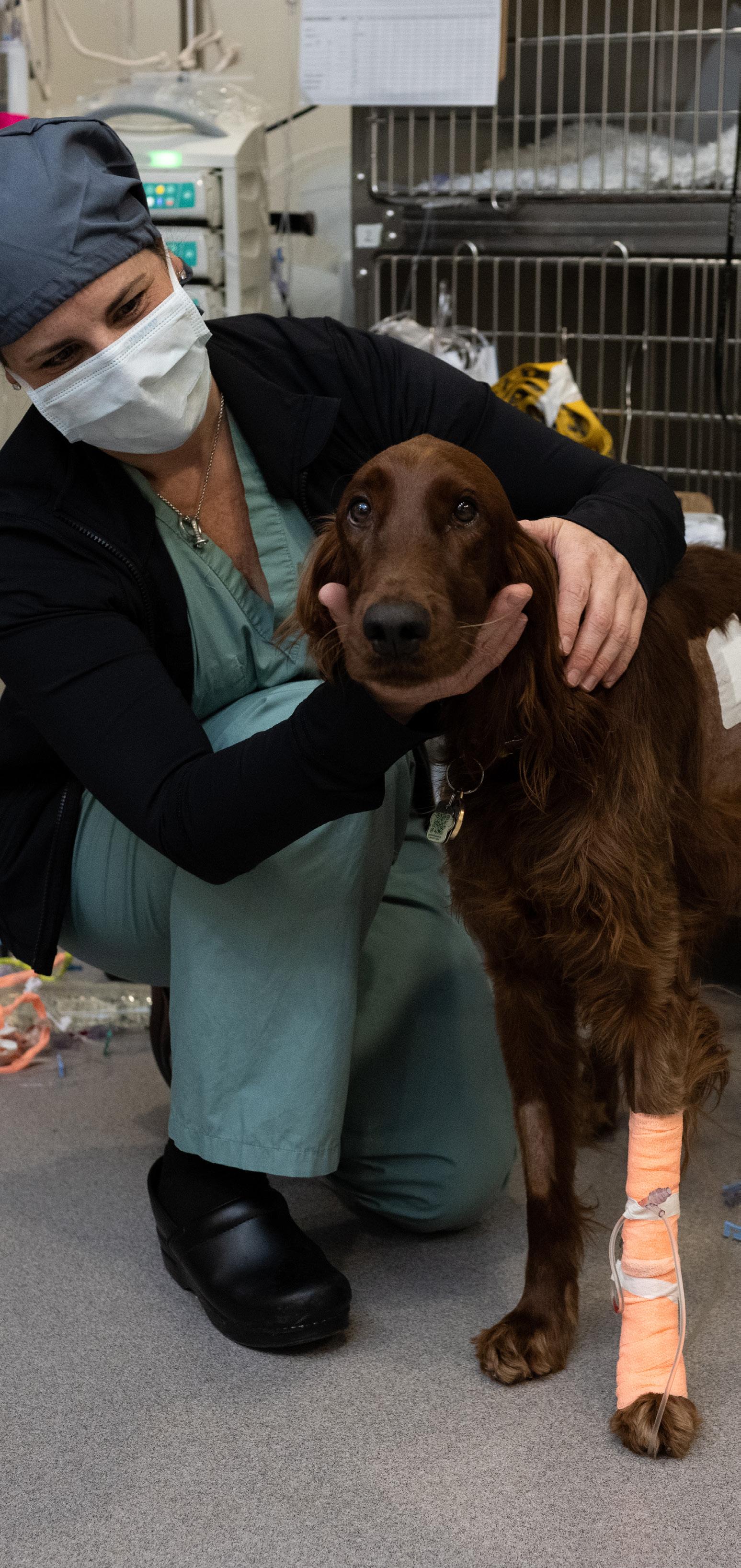 Dr. Geoff Wood
Dr. Geoff Wood
Hemangiosarcoma (HSA) is a cancer that arises from blood vessel walls. It is common in dogs and can be fatal. HSA often occurs in the spleen or heart, but because it has usually spread when it is found, surgery alone does not stop it and chemotherapy can only help a little. However, if it is still in one body part, it may be completely removed by surgery. This study aims to create a simple, non-invasive blood test that can detect HSA early on before it spreads. It will use blood samples from dogs to measure substances called microRNA. The study will also follow up on its recent finding that specific microRNAs can help predict how long a dog with HSA will live after surgery and chemotherapy. The long-term goal is to see how far ahead of time HSA can be detected.
Rewiring Tumor Cell Death to Improve Immunotherapy of Tumours in Dogs
Dr. Samuel Workenhe
Cancer immunotherapy uses the immune system to attack existing tumors and prevent new ones. However, cancers have found ways to evade the immune system. This study will test a new idea for immunotherapy. Stressed and dying tumors send messages that alert immune cells to potential dangers, similar to an alarm signal. The study’s researchers have identified a type of tumor cell death that awakens the immunity cycle. This study will evaluate the ability of this type of cell death to make dog tumors release danger signals that alert immune cells. This could help develop new treatments for pets with cancer.
COMPANION ANIMAL HEALTH
Tick Bites and Tick-borne Diseases: Investigating Pet Owners’ Thoughts Around Tick Prevention
Drs. Katie Clow & Kelsey Spence
Ticks are a growing health concern for dogs and cats. As the risk of acquiring disease-causing pathogens from ticks increases, making sure to prevent tick bites becomes even more important. There is little research on factors that influence tick prevention behaviours among pet owners. This study will investigate the thoughts of dog and cat owners in Ontario regarding tick prevention behaviours (e.g., tick checks, use of tick prevention products). Identifying challenges around tick prevention behaviours that pet owners may face can help address these barriers and improve veterinaryclient communication on tick prevention to ultimately reduce the risk of tick-borne diseases.
In photo: OVC patient Ladybird. Photo credit: Scott McQuarrie, scottmcquarrie.com.
Fixing Fractures Using Locking Plates Outside of the Skin
Dr. Melissa MacIver
Fractures are a common injury in people and animals. Surgeons must choose the best way to fix them that preserves blood supply and minimizes damage to surrounding tissues. Recently, there has been an emphasis on causing less tissue damage. However, many implants that do so can be bulky, costly and cause infections. So, many surgeons rely on plates and screws instead. Recently, surgeons have shifted from using non-locking plates to locking plates. Locking plates cause less tissue damage since they can be placed further from the bone. Using locking plates outside of the bone may be a useful method. This study will evaluate two types of locking plates placed outside of the skin to see if they are equal in strength to other methods.
Risk Factors for Inadequate Care and Giving Up Companion Rabbits
Dr. Lee Niel
Many pet rabbits find themselves in shelters and in need of new homes. Knowing more about human-rabbit attachments, relationships and behavioural interactions
can help provide solutions for future and current rabbit owners. This research aims to set rabbit owners up for success by figuring out what is associated with stronger attachments, relationships and more frequent and positive interactions. By identifying important social and environmental factors, the results could help educate rabbit owners and veterinarians.
EQUIPMENT
A Machine that Helps Warm Up Animals (3M Bair Hugger Warming Unit 375)
Dr. Alice Defarges
This machine helps warm air moving inside blankets to warm patients up. It is small, convenient, and a very safe device to warm up animals such as cats and dogs.
Pumps that Give Animals Fluids (Infusomat Space Pump and Perfusor Space Pump)
Dr. Alice Defarges
The Infusomat space pump can give large amounts of fluids and many types of fluids bedside. The Perfusor
space pump can give very small amounts of drugs or fluids. Both pumps are small, light, and safe.
A Monitor for Anesthesia (PetMAP+II NIBP/Nonin SpO2 Monitor with 5” Display Benson Medical)
Dr. Alice Defarges
This is a hand-held monitor for small animals under general anesthesia and at recovery. It monitors animals to help avoid complications that can be life-threatening.

A Machine that Assesses Bone Implants (Model 68SC-2 Single Column Series with Component Test Plate)
Dr. Melissa MacIver
This machine measures the strength of implants in broken bone repairs. It does tests that assess forces acting on implants when moving.
25
In photo: OVC patient Brady. Photo credit: Scott McQuarrie, scottmcquarrie.com.
by Suzi Beber

A Tribute to Smiling Blue Skies
Supporter Marilyn Pocock
“Goldens disappear, but they never really go away. The spirits up there put the sun to bed, wake up the grass, and spin the earth in dizzy circles. Sometimes you can see them dancing in a cloud during the daytime when they’re supposed to be sleeping. They paint the rainbows and sunsets and make waves splash and tug at the tide. They toss shooting stars and listen to wishes. And when they sing wind songs, they whisper to us, “Don’t miss me too much. The view is nice, and I’m doing just fine.” (Ashley Rice, 1999)
I imagine Marilyn sitting on a cloud surrounded by her Goldens, her light ever a beacon that is shining down on us all, as we thank her for her generosity of spirit, helping us to help our heart dogs through her bequest to The Smiling Blue Skies Cancer Fund.


Six degrees of separation . . . While Marilyn began her teaching career in the York Region, I was almost next door, with the Halton Board of Education, and while Marilyn’s career stretched over four decades, coaching and championing girls and women in sport, my career in education was cut short, but both of our
hearts overflowed with the love we had for our Golden Retrievers.
Marilyn’s life with and love for Goldens began with “Misty,” Albanor’s Heather Mist, a precious gift from her sister, Dorothy, laying the foundation for Marilyn’s dream of breeding her own Golden Retrievers. Out of Marilyn’s first litter, there was “Nicky,” Lynwood’s Artful Dodger, and Heather and Neil’s “Genna,” Lyndold’s Genesis. Six degrees of separation—Aileen and Heather— supporters of Smiling Blue Skies from the very start, and adventures in Golden Rescue, and dogs I had long admired, like Shelly’s Boss “Hog,” sired Marilyn’s first litter.
That first litter led to another six degrees of separation, when Marilyn met Liz of Prospector Goldens, and out of Marilyn’s second litter, sired by “Dickens,” Marilyn’s dreams really took flight when she bred Liz’s Sierra to Dickens, and puppies “Taylor” and “Geordie” grew up to fly around conformation show rings, piloted by Graeme Burdon, one of Canada’s very best handlers. Marilyn loved travelling from show to show and the thrill never wore off. Her dogs were always in the ribbons and their breed championships
were wonderful moments that became treasured memories. I remember seeing Marilyn’s name on a Golden Retriever Club of Canada trophy, when I was just starting out with Blues, watching him in his first shows.
Marilyn has been described as a “force to be reckoned with.” With “Splash” by her side, Marilyn left this earth to be amongst the brightest of stars in the evening skies, November 26, 2021. She has left a legacy to her many students, and her love affair with Golden Retrievers continues in such a special way, through her gift to The Smiling Blue Skies Cancer Fund. $745,036.59 has been bequeathed to help us change the face of cancer.
Marilyn had a heart of gold.
26 CELEBRATING 21 YEARS . . . “THERE WILL ALWAYS BE SMILING BLUE SKIES”
Marilyn’s dog, Splash, and friend Gayle with OVC Pet Trust Director Kim Robinson. Photo credit: Sandra Valeriote.
Suzi Beber founded The Smiling Blue Skies ® Cancer Fund in 2001, after losing her Golden Retriever, Blues, to lymphoma. To honour his memory, and in gratitude for the care he received at OVC, Smiling Blue Skies has raised more than $2.1 million to support OVC Pet Trust’s quest to find more and better ways to deal with canine cancer.
@OVCPetTrust launches Instagram
Are you a pet owner, animal lover or veterinary professional on Instagram? You can now find OVC Pet Trust on Instagram and we would love it if you’d join our community.
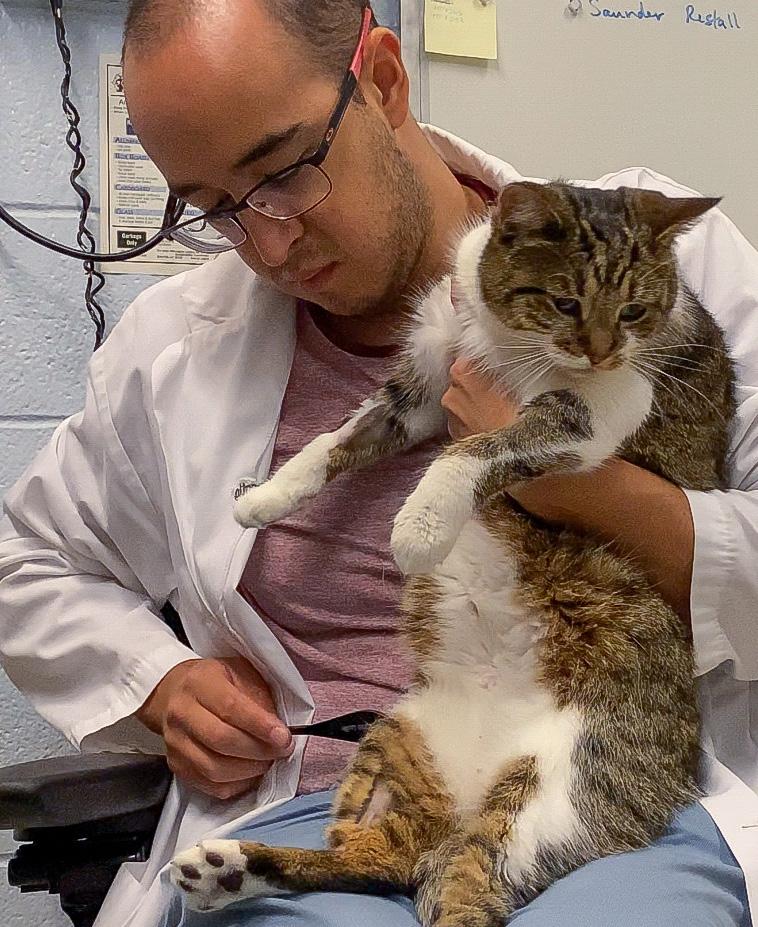





Follow along for news and impact stories of what it means to support OVC Pet Trust and give back to companion animal health and well-being. Go behind the scenes at the Ontario Veterinary College and see how your support makes a true difference in the lives of pets and the people who love and care for them.
Connect with us @OVCPetTrust.

27
Dog and cat patients are cared for by veterinary teams at the OVC Companion Animal Hospital.
Photos by Ashleigh Martyn.
ovcpettrust
Connect
with OVC Pet Trust on social media to share your
WATCH
1. The 12th Annual OTS Dog Jog in March 2022 raised $11,230 for OVC Pet Trust — and more than $120,000 since the event began in 2011. In photo: Dog Jog participants Bentley and Walnut.
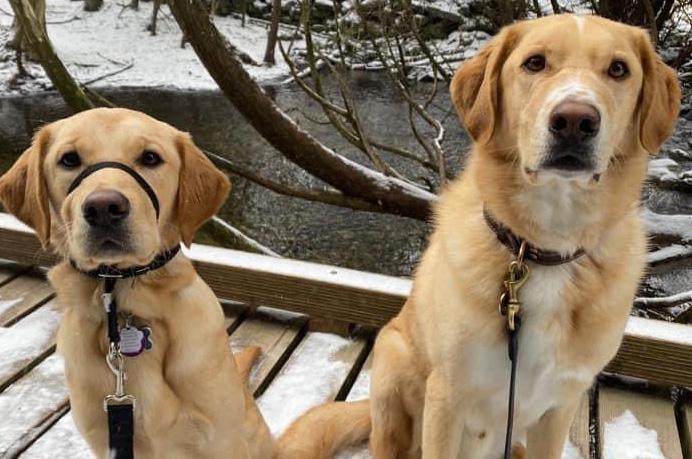
2. The 19th Annual Smiling Blue Skies Calgary Walk for Canine Cancer raised more than $34,000 in May 2022. Photo supplied by Leanne Tucker.
3. In August 2022 Ren’s Pets and their customers raised more than $47,000 during Dogust to advance companion animal health through OVC Pet Trust. In photo: OVC cancer patient Buddy and his family at Ren’s Guelph.




CANADA POST - POSTAGE PAID PUBLICATIONS
MAIL 40064673
WWW.PETTRUST.CA PET TRUST PALS 4 1 2 3 4
www.pettrust.ca
4. Our friends on TikTok raised $1,991.50 for OVC Pet Trust. In photo: Arthur and Molly the Bulldog present OVC’s Kim Robinson and Sandra Valeriote with a cheque for the funds raised from their community to support cancer care and research at the Ontario Veterinary College. stories
and photos: Facebook (facebook.com/ovcpet), Twitter (@OVCPetTrust) and Instagram (@OVCPetTrust).
IF UNDELIVERED, PLEASE RETURN TO SENDER: Ontario Veterinary College, University of Guelph 50 Stone Road East, Guelph, Ontario Canada N1G 2W1
Attention: OVC Pet Trust, OVC Main Building, Dean’s Office
OVC PET TRUST
OUR
TO SEE HOW OVC PET TRUST IMPACTS COMPANION ANIMAL HEALTH
OVC Pet Trust is part of the University of Guelph, a registered charity. You can visit our website to support companion animal health at www.pettrust.ca. The University of Guelph charitable registration number: 10816 1829 RR 0001
VIDEO
Or find the video online at uoguel.ph/petswelove.








 Robinson Director, OVC Pet Trust Ontario Veterinary College University of Guelph
Robinson Director, OVC Pet Trust Ontario Veterinary College University of Guelph
























 Dr. Geoff Wood
Dr. Geoff Wood















